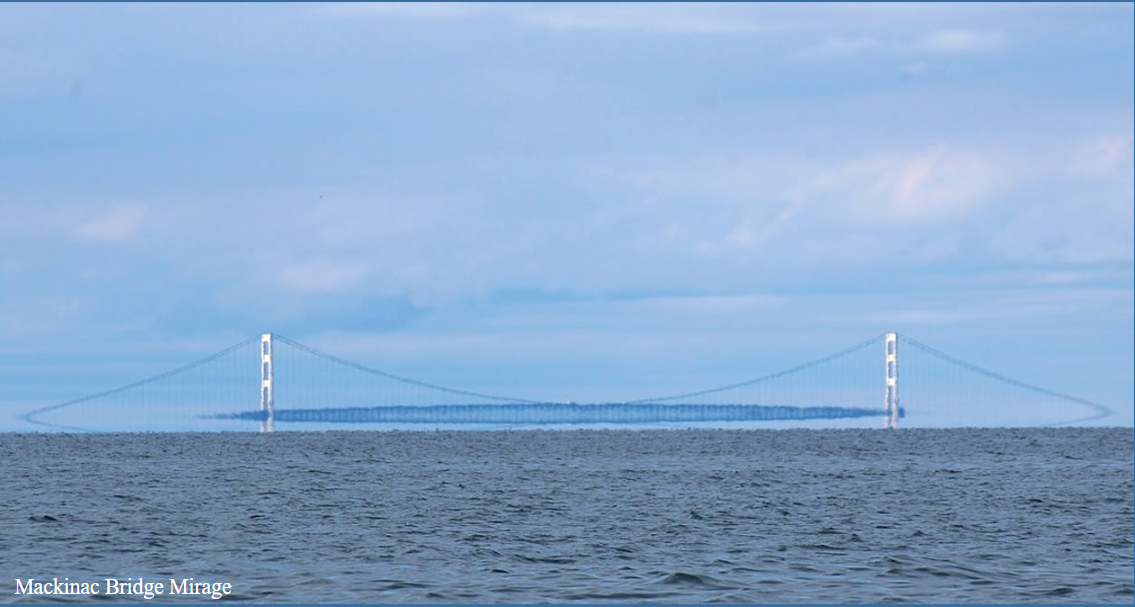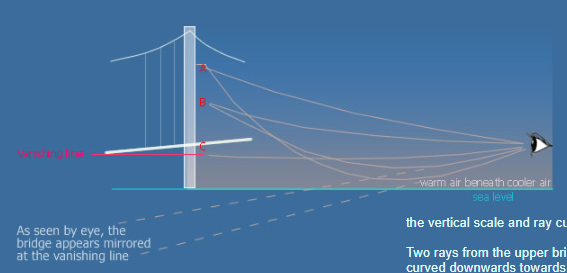OPOD - Mackinac Bridge Mirage, Michigan
OPOD - Mackinac Bridge Mirage, Michigan
Have you ever witnessed a mirage that seemed to defy reality? One such fascinating phenomenon is the Mackinac Bridge Mirage, captured in stunning images by David N Hart in Michigan, USA. This mirage showcases the central 1158m roadway and cables of the bridge, appearing as if they are perfectly mirrored. However, what makes this mirage even more intriguing is that sections of the approach roadway seem to vanish from view. In this blog post, we will delve into the science behind this captivating "inferior mirage" and explore the intricate details of this optical phenomenon.
Inferior mirages occur when warm air lies beneath cooler air, resulting in a bending of light rays as they traverse the temperature gradients between horizontal layers of air. As a result, the mirage image appears below the usual view. The Mackinac Bridge Mirage is a prime example of this phenomenon, where light rays from the bridge undergo refraction, creating a mesmerizing visual effect.
The extent of refraction in inferior mirages can vary, but in this case, the miraging is primarily visible close to the horizon and when the object is at a distance. David Hart captured this awe-inspiring mirage from a location approximately 16 miles away between Cheboygan and Bois Blanc Island on Lake Huron. Positioned about 5.5 feet above the water level, he was able to witness the dramatic alterations of the mirage with changes in height.
Now let's take a closer look at the intricate details of the Mackinac Bridge Mirage. As with most inferior mirages, the miraged view is inverted. However, this particular mirage exhibits additional complexities. One notable feature is the "vanishing line" effect, where the bridge is mirrored slightly below the central span roadway. Everything below this mirrored level appears to vanish from sight. The true horizon becomes invisible, replaced by the miraged sky. The apparent choppy "horizon" observed is merely the lower edge of the mirage.
To better understand the optical principles at play, let's explore a ray diagram. Although the diagram below exaggerates the vertical scale and ray curvature, it effectively illustrates the effects observed in the Mackinac Bridge Mirage. Two rays from the upper bridge reach the observer's eye. The upper ray curves slightly downwards towards the warmer air, while the lower ray sharply bends and appears to originate from a reflection in the water. Rays from lower portions of the bridge exhibit similar behavior. However, at a specific position, marked as (C), only one ray reaches the eye. Rays from beneath this level cannot reach the observer's eye, rendering that portion of the bridge and water invisible.
The level marked as (C) corresponds to the mirage's "vanishing line." At this level, the "real" view and the inverted mirage view converge, obscuring any details below it from the observer's sight. It's worth noting that the higher the vanishing line, the more distant the object appears. In the case of the Mackinac Bridge Mirage, which David Hart witnessed from 16 miles away, the vanishing line is notably high.
The Mackinac Bridge Mirage serves as a captivating example of how atmospheric conditions can distort our perception of reality. By understanding the science behind these optical phenomena, we can appreciate the beauty and complexity of nature's visual illusions. Next time you find yourself near a large body of water on a warm day, keep an eye out for any mirages that may arise, for you never know when you might witness a mesmerizing sight like the Mackinac Bridge Mirage.
Note: This blog post has been crafted to provide a detailed and thorough exploration of the Mackinac Bridge Mirage phenomenon. It aims to shed light on the science behind the mirage and the intricacies of its visual effects. The original article, which inspired this post, can be found here.

Mackinac Bridge Mirage
David N Hart imaged the Mackinac Bridge in Michigan, USA with its central 1158m roadway and cables mirrored. Approach sections of the roadway are rendered invisible by the mirage. Images ©David N Hart, shown with permission.
Warm air beneath cooler air is responsible for this "inferior mirage", named inferior because the mirage image is below the view normally seen.
Light rays from the bridge are refracted as they traverse the temperature gradients between the horizontal layers of air.
The extent of refraction is often quite small and in that event the miraging is only evident close to the horizon and when the object is at some distance. David Hart was about 16 miles away between Cheboygan and Bois Blanc Island on Lake Huron. He was about 5.5.ft above the water level. Mirages can alter dramatically with height.

As usual with an inferior mirage, the miraged view is inverted - but inferior mirages can be much more complex.
This mirage shows the 'vanishing line' effect very well. The bridge is mirrored at a level slightly below the central span roadway. Everything below that has vanished. The true horizon is invisible having been replaced by miraged sky. The apparent very choppy ‘horizon’ is purely the lower edge of the mirage.
The ray diagram at left grossly exaggerates the vertical scale and ray curvature in order to portray the effects.
Two rays from the upper bridge (A) reach the eye. The upper ray is slightly curved downwards towards the warmer air. The lower ray is sharply curved and appears to the eye to come from a reflection in the water. Rays from lower down (B) do the same. Position (C) is different. Only one ray reaches the eye. Rays from beneath (C) cannot reach the eye at all - that part of the bridge and water is invisible.
The level (C) is the level of the mirage "vanishing-line". The 'real' view and inverted mirage view join at the vanishing line and the eye can see no details of the scene that are below it. The more distant the object, the higher is the vanishing line. In this mirage seen from 16 miles away the vanishing line is quite high.
Note: this article has been automatically converted from the old site and may not appear as intended. You can find the original article here.
Reference Atmospheric Optics
If you use any of the definitions, information, or data presented on Atmospheric Optics, please copy the link or reference below to properly credit us as the reference source. Thank you!
-
<a href="https://atoptics.co.uk/blog/opod-mackinac-bridge-mirage-michigan/">OPOD - Mackinac Bridge Mirage, Michigan</a>
-
"OPOD - Mackinac Bridge Mirage, Michigan". Atmospheric Optics. Accessed on December 23, 2024. https://atoptics.co.uk/blog/opod-mackinac-bridge-mirage-michigan/.
-
"OPOD - Mackinac Bridge Mirage, Michigan". Atmospheric Optics, https://atoptics.co.uk/blog/opod-mackinac-bridge-mirage-michigan/. Accessed 23 December, 2024
-
OPOD - Mackinac Bridge Mirage, Michigan. Atmospheric Optics. Retrieved from https://atoptics.co.uk/blog/opod-mackinac-bridge-mirage-michigan/.